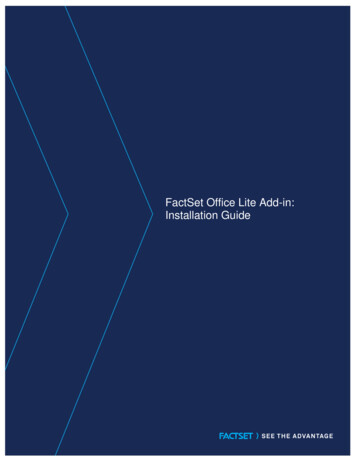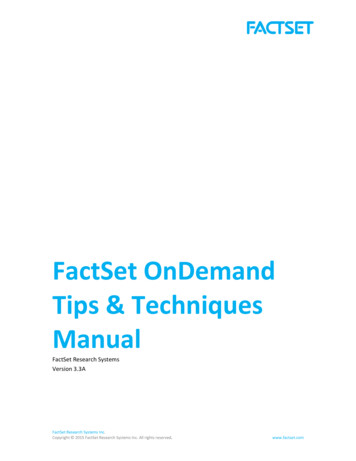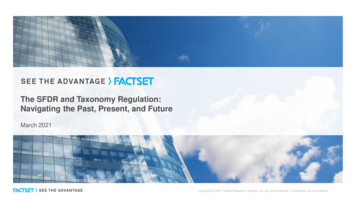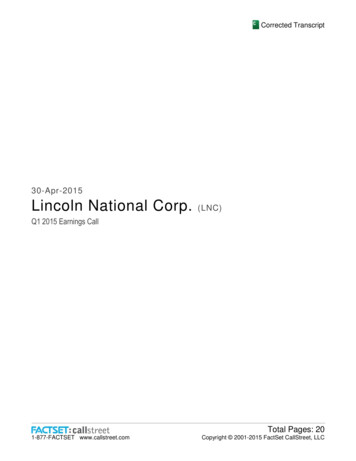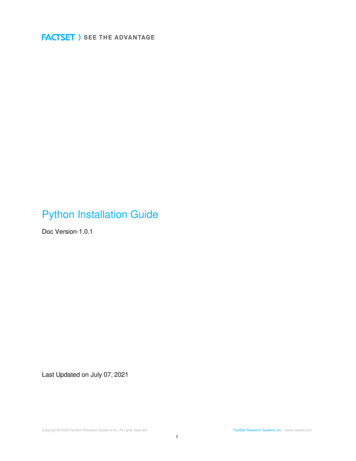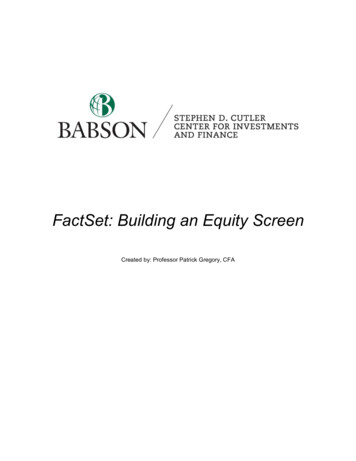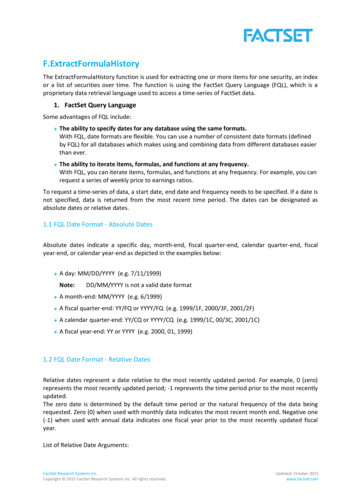
Transcription
F.ExtractFormulaHistoryThe ExtractFormulaHistory function is used for extracting one or more items for one security, an indexor a list of securities over time. The function is using the FactSet Query Language (FQL), which is aproprietary data retrieval language used to access a time-series of FactSet data.1. FactSet Query LanguageSome advantages of FQL include: The ability to specify dates for any database using the same formats.With FQL, date formats are flexible. You can use a number of consistent date formats (definedby FQL) for all databases which makes using and combining data from different databases easierthan ever. The ability to iterate items, formulas, and functions at any frequency.With FQL, you can iterate items, formulas, and functions at any frequency. For example, you canrequest a series of weekly price to earnings ratios.To request a time-series of data, a start date, end date and frequency needs to be specified. If a date isnot specified, data is returned from the most recent time period. The dates can be designated asabsolute dates or relative dates.1.1 FQL Date Format - Absolute DatesAbsolute dates indicate a specific day, month-end, fiscal quarter-end, calendar quarter-end, fiscalyear-end, or calendar year-end as depicted in the examples below: A day: MM/DD/YYYY (e.g. 7/11/1999)Note:DD/MM/YYYY is not a valid date format A month-end: MM/YYYY (e.g. 6/1999) A fiscal quarter-end: YY/FQ or YYYY/FQ (e.g. 1999/1F, 2000/3F, 2001/2F) A calendar quarter-end: YY/CQ or YYYY/CQ (e.g. 1999/1C, 00/3C, 2001/1C) A fiscal year-end: YY or YYYY (e.g. 2000, 01, 1999)1.2 FQL Date Format - Relative DatesRelative dates represent a date relative to the most recently updated period. For example, 0 (zero)represents the most recently updated period; -1 represents the time period prior to the most recentlyupdated.The zero date is determined by the default time period or the natural frequency of the data beingrequested. Zero (0) when used with monthly data indicates the most recent month end. Negative one(-1) when used with annual data indicates one fiscal year prior to the most recently updated fiscalyear.List of Relative Date Arguments:FactSet Research Systems Inc.Copyright 2015 FactSet Research Systems Inc. All rights reserved.Updated: October 2015www.factset.com
D0D is the most recent trading day, -1D is one trading day prior.WE0WE is the most recent trading week end, -1AW is the one actual week (7 days) prior to themost recent.W0W is the last day of the most recent trading week (usually Friday), -1W is the last tradingday of the prior week.AM0AM is the most recent trading day, -1AM is the same day, one actual month prior.M0M is the last trading day of the most recent month, -1M is the last trading day of the priormonth.AQ0AQ is the most recent trading day, -1AQ is the same day 3 months priorQ0Q is the last trading day of the company’s most recent fiscal quarter, -1Q is the last day ofthe prior fiscal quarter.CQ0CQ is the last trading day of the most recent calendar quarter (March, June, September,or December), -1CQ is the last trading day of the prior calendar quarter.AY0AY is the most recent trading day, -1AY is one actual year (365 days) priorY0Y is the last trading day of the company’s most recent fiscal year, -1Y is the last tradingday of the prior fiscal year.CY0CY is the last trading day of the most recent calendar year (the last trading day inDecember), -1CY is the last trading day of the prior calendar year.2. F.ExtractFormulaHistory syntaxThe syntax for the F.ExtractFormulaHistory function is:data F.ExtractFormulaHistory(ids, items, date, optional arguments)where,dataidsitemsdatesvariable name for the data returnedCellString array with a list of one or multiple security identifiersCellString array with a list of one or more FactSet data items in the Screening languageDate range and frequency entered using actual or relative dates. A valid FactSetfrequency (e.g. ‘d’dates Alternate method of entering dates entered in start:end:freqformat. (e.g. ‘20101215:20110115:d’)Optional arguments,currThe currency in which the data is to be returned, using a string with the threecharacter ISO code (e.g. ‘USD’ or ‘EUR’).FactSet Research Systems Inc.Copyright 2015 FactSet Research Systems Inc. All rights reserved.Updated: October 2015www.factset.com
ypefeelbackrefreshCalendar setting, arguments include:LOCAL: Uses the local trading calendar for each security. Local exchange holidayswill be skippedFIVEDAY: Displays Monday through Friday, regardless of whether there weretrading holidays.FIVEDAYEOM: Displays Monday through Friday including a weekend date if it fallson the last day of the month. Where the month-end does not fall on a weekend,the calendar will act just as the standard five-day calendar.SEVENDAY: Displays Monday through Sunday.AAM: For Exchange code uses the calendar of a specific exchange, represented bythe exchange code. If there is no calendar available for a specific exchange, thecalendar will default to FIVEDAY.Screening expression to limit the universeIson-codes can be used to limit the universe ISON MSCI WORLD(0,1) is written as‘ison’,’msci world’,’isonParams’,’0,1’The arguments within brackets in the ison-codeUniverse is the constituents of an OFDB file, default directory is Client, if the OFDBis stored in another location the path must be includedSpecific date for the constituents of the OFDBPositionally set according to the items in the selection, ie ‘decimals’,’,,3,4,3’The optional argument allows users to define a data type for a data item columnthat is NA for the entire column. This option must be defined for everycolumn/data item requested in the command if it is used at all.Setting to control data is not falling forward and display NAs instead of carryingforward values, for those databases that do so (using ‘feelback’,’n’).This will refresh the connection to FactSet servers to capture the latest databaseupdates. This only needs to be used when a refresh is necessary. It is notrecommended to leave this argument in every request made. To use this, therefresh argument should be paired with the value “Y”.Example 1:In this example extract the last 6 quarters EPS for Exxon Mobile (ticker XOM) using the FQL codeFG EPS.data F.ExtractFormulaHistory('XOM','FG EPS(0Q,-5Q,Q)','0Q:-5Q:Q');With the Output:R:IdDate fg.eps1 xom 2012-12-312 xom 2013-03-313 xom 2013-06-304 xom 2013-09-305 xom 2013-12-316 xom 2014-03-319.479.709.827.967.667.37MATLAB:Id: 'xom'Date: [735234 735324 735415 735507 735599 735689]fg eps: [9.4700 9.7000 9.8200 7.9600 7.6600 7.3700]FactSet Research Systems Inc.Copyright 2015 FactSet Research Systems Inc. All rights reserved.Updated: October 2015www.factset.com
In this example, the date argument is using relative rather than absolute dates. To specify relativedates, enter the number of periods and a period code, such as D for days, W for weeks, or Q forquarters and Y for years. When using relative dates, "0" refers to the most recent time period.Therefore, 0Q refers to the most recent quarter end, while -1Q refers to two quarters ago.Example 2:In this example, extract the last 6 periods of pricing and sales data for Microsoft and IBM using thepricing database with the FQL code P PRICE and the FactSet Fundamentals database for sales datawith the FQL code FF SALES. Both P PRICE and FF SALES in this example are used in the itemsparameter.data F.ExtractFormulaHistory('MSFT,IBM','P PRICE(-5,0,Q,USD),FF SALES(QTR,-5,0,Q,,USD)','-5:0:Q');Note: To most efficiently ensure that that the dates for the different items (here price and sales) aligncorrectly with the dates field, the dates should be included both in the FQL code and in the datesparameter as specified above.Example 3:In this example, extract the price for Google for the date range 12/31/1989 until 12/31/2001 on amonthly frequency. Since there is no available price data for Google starting in 1989, the data wouldbe NA. When using the ExtractFormulaHistory function the data type can be specified for treatment ofNA’s, for example as a double or integer.data F.ExtractFormulaHistory('GOOGL','P 2001:M','datatype','DOUBLE');Note: By default, the data type returned is determined by the first value of the items being returned.In the following case the p price code returned as a character by default because the values forGOOGL are NA (if the request is made for just IBM with the same date range the p price data isreturned as a double since the data is available for IBM). But with the addition of the ‘datatype’optional argument, it is possible to specify how the data is returned.Example 4:In this example, retrieve the 60 month beta coefficient for Exxon Mobile relative to the S&P 500. TheFactSet BETA function measures a security or portfolio's volatility relative to an index. If a security hasa beta coefficient greater than one, it is considered more volatile. If a security has a beta coefficient ofless than one, its price can be expected to rise and fall more slowly. In the FQL syntax, the BETAfunction returns the coefficient relative to an index and over any period of time that you specify.R: data 9M,M)','')MATLAB: data 9M,M)','')Note: Single quotes in an FQL formula needs to be escaped by a backslash (R) or single quote(MATLAB).Example 5:FactSet Research Systems Inc.Copyright 2015 FactSet Research Systems Inc. All rights reserved.Updated: October 2015www.factset.com
This example is using some of the FQL functions that are available, such as AVG, MAX, MIN, STD, etc.FactSet offers hundreds of functions and a comprehensive alphabetical list of functions is available onOnline Assistant page 1410.Here the average, maximum, minimum, and standard deviation of earnings per share (EPS) values forGeneral Electric are extracted, for the last 6 quarters of history. The EPS values are coming from theFactSet Fundamentals database using the FQL code FF EPS(QTR,0,-5,Q).data F.ExtractFormulaHistory('GE','AVG(FF EPS(QTR,0,-5,Q)) ,MAX(FF EPS(QTR,0,-5,Q)),MIN(FF EPS(QTR,0,5,Q)),STD(FF EPS(QTR,0,-5,Q))','')Note: The FactSet AVG function returns the average, or mean, value of the data values requested andignores non-available data over the specified time period. For example, when calculating the averageannual sales over the last 10 years, if one out of the 10 years is unavailable, you will still get an averageusing the 9 years of available data.The FactSet STD function returns the standard deviation by first finding the average of the data set.Each data item is then subtracted from the average, and the difference is squared. The sum of thesquared values is divided by the number of data items minus one. The function returns the squareroot of that value.Example 6:In this example, retrieve the last 2 quarters of EPS and price for the current constituents of the S&P500 using the FQL codes FF SALES and P PRICE and the names of the companies using the FQL codePROPER NAME. The universe, which is specified as the S&P 500, is based on the FQL codeISON SP500, returns the current constituents of the S&P 500.data F.ExtractFormulaHistory('','PROPER NAME,FF EPS(QTR,0,-1,Q),P PRICE(0,-1,Q)','0:-1:Q','ison','SP500');Example 7:In this example, retrieve proprietary data stored uploaded into FactSet and stored in an Open FactSetDatabase (OFDB). OFDB is a high-performance multi-dimensional database system used to securelystore proprietary numeric and textual data on FactSet.OFDB is ideal for users who manage large portfolios or maintain extensive historical proprietarydatabases. OFDB optimizes large, multi-dimensional databases, giving FactSet users highly flexible,factset access to large volumes of complex data that can be used in many different applications. OFDBis based upon Online Analytical Processing technology, which is the basis for multi-dimensionaldatabases.Here the latest closing price using P PRICE for the constituents of an OFDB is extracted. The OFDB inthis example is saved in the default client directory and is called MyOFDB. To test this example,reference an actual OFDB file that can be accessed using the credentials used.data F.ExtractFormulaHistory('','P PRICE(0D)','0','ofdb','MyOFDB');Note: When data is extracted from an OFDB and no directory, such as Client or Personal is specified,the default path is referencing the Client directory within the FactSet workstation.FactSet Research Systems Inc.Copyright 2015 FactSet Research Systems Inc. All rights reserved.Updated: October 2015www.factset.com
Note: When using the ‘ofdb’ parameter, the retrieved constituents are latest available. In order toextract a more dynamic universe of constituents of an OFDB as of a specific date, an ‘ofdbDate’argument must be used. The request would thus be set up as:data F.ExtractFormulaHistory('','P PRICE(0D)','0','ofdb','MyOFDB', 'ofdbDate','20120105')Example 8:In this example the last year’s quarterly Market Value is extracted for a universe defined as the 50companies with the highest EPS from the selection of US Companies with a Market Value greater than10 billion US Dollar.R:data F.ExtractFormulaHistory('','P MARKET VAL(0,-1Y,Q)','0:-1Y:Q','universe','URANKX((P MARKET VAL(0,USD) 10000ANDCONTAINS(P EXCOUNTRY,\'UNITEDSTATES\')) 1,FF EPS(QTR,0)) 50S');MATLAB:data F.ExtractFormulaHistory('','P MARKET VAL(0,-1Y,Q)','0:-1Y:Q','universe','URANKX((P MARKET VAL(0,USD) 10000ANDCONTAINS(P EXCOUNTRY,''UNITEDSTATES'')) 1,FF EPS(QTR,0)) 50S');Note: The universe parameter should only be used for smaller universes (less than 500 securities)when used with the ExtractFormulaHistory factlet.Example 9:In this example, for the securities IBM, Microsoft and Nokia, extract the total return from 1 trading daybefore latest quarterly EPS report date until 1 day after the latest quarterly EPS report date. In thisexample demonstrating the use of addition, however, subtraction, division and multiplication can beperformed as well.data F.ExtractFormulaHistory('IBM,MSFT,NOK','P TOTAL RETURN( FF EPS RPT DATE(QTR,0)1D,FF EPS RPT DATE(QTR,0) 1D)','');FactSet Research Systems Inc.Copyright 2015 FactSet Research Systems Inc. All rights reserved.Updated: October 2015www.factset.com
www.factset.com F.ExtractFormulaHistory The ExtractFormulaHistory function is used for extracting one or more items for one security, an index or a list of securities over time. The function is using the FactSet Query Language (FQL), which is a proprietary data retrieval language used to access a time-series of FactSet data. 1. FactSet Query .
